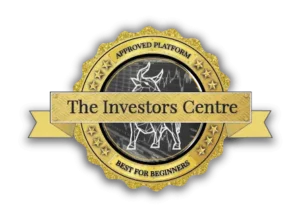Quick Answer: To Start Investing With £100, You'll Need to:
Starting to invest with only £100 is achievable by opening an account on a low-fee platform. Consider micro-investing apps or fractional shares in ETFs to diversify your portfolio gradually and cost-effectively, leveraging compound interest over time.
Featured Partner - Etoro


eToro is a multi-asset investment platform. The value of your investments may go up or down. Your capital is at risk.
Introduction to Investing
Investing can often seem like a daunting venture, especially if you’re just starting out or working with a limited budget. However, even with as little as £100, you can embark on this exciting journey. Here’s a breakdown of what investing really entails and why you should consider it, based on my personal experience.
What Does Investing Mean?
Investing is the act of allocating resources, usually money, with the expectation of generating an income or profit. You’re essentially putting your money into assets that you believe will increase in value over time. From my own journey, I’ve learned that investing isn’t just about making money quickly. It’s about setting your funds into various channels such as stocks, bonds, mutual funds, or even real estate, hoping they grow in value. Here’s how you can look at it:
- Long-term growth: Investing your money can significantly grow your wealth over time due to the power of compound interest and market growth.
- Income generation: Certain investments, like dividend stocks or real estate, can provide a steady income stream.
Why Should You Consider Investing?
Choosing to invest, especially early in life, is a wise decision for several reasons:
- Building wealth: My experience has shown that investing is one of the most effective ways to build wealth. Even small amounts can grow substantially over time.
- Outpacing inflation: By investing, your money potentially grows faster than the rate of inflation, helping preserve your purchasing power.
- Achieving financial goals: Investing can be a crucial step towards reaching financial milestones, such as saving for retirement or buying a home.
Investing isn’t just for the wealthy; it’s a tool available to anyone aiming to improve their financial future, even with limited starting capital like £100.

Understanding Your Investment Options with £100
Even if you’re starting with just £100, there are several accessible investment options. Each has its own risks and benefits, and here’s my take on what these investments can offer based on personal experiences and observations.
Stocks and Shares
Investing in stocks means buying a fraction of ownership in a company. Even with £100, you can buy shares of companies, particularly through fractional shares where you purchase parts of a single share. This can be a good way to get exposure to high-value stocks:
- Potential for growth: Stocks have the potential for significant price appreciation.
- Dividend income: Some stocks pay dividends, which can provide a small income stream.
Bonds and Gilts
Bonds and gilts represent loans made by the investor to a company or government in exchange for periodic interest payments and the return of the bond’s face value at maturity. They are generally considered safer than stocks:
- Steady income: Bonds typically offer fixed interest payments, making them attractive for risk-averse investors.
- Preservation of capital: Government bonds, especially gilts issued by the UK government, are low-risk in terms of default.
Mutual Funds and ETFs
Mutual funds and ETFs (Exchange-Traded Funds) allow investors to pool their money to invest in a diversified portfolio of stocks, bonds, or other assets. With £100, you can invest in these funds, which are managed by professionals:
- Diversification: By investing in a range of assets, these funds reduce the risk of losing money on your investment.
- Accessibility: ETFs are traded like stocks and often have lower investment minimums, making them ideal for small budgets.
Peer-to-Peer Lending
Peer-to-peer lending platforms connect borrowers directly with investors. You can lend small amounts of money to various borrowers as a way to diversify:
- Higher returns: Often offers higher returns compared to traditional savings and investment products.
- Risk of default: There is a risk of borrowers defaulting on their loans, which can lead to losses.
Micro-Investing Apps
Micro-investing apps round up your everyday transactions to the nearest pound and invest the spare change. This is a painless and automatic way to invest:
- Regular saving: Helps build investment habits by automating savings and investment.
- Wide range of investment options: Many apps offer portfolios of stocks, bonds, or ETFs tailored to different risk levels.
Each of these options offers a different balance of risk and potential return, and they can all be suitable for someone starting with a modest sum like £100. Whether it’s the growth potential of stocks, the stability of bonds, the diversified nature of mutual funds and ETFs, the direct impact of peer-to-peer lending, or the ease of micro-investing apps, there’s a pathway for every type of investor to begin their journey.

Setting Up Your Investment Goals
Short-Term vs Long-Term Goals
When setting investment goals, consider your time horizon. Short-term goals might include saving for a holiday or an emergency fund, typically within a year or two. These investments should be low-risk, as you’ll need access to your money relatively soon. Long-term goals, such as retirement or purchasing a home, allow more time for your investments to grow and recover from volatility. You can afford to take on higher-risk investments with potentially higher returns, as you won’t need the money immediately.
Risk Assessment
Assessing your risk tolerance is crucial before investing. It determines how much market volatility you can comfortably handle without panicking. If a significant drop in your investment value will keep you awake at night, consider more conservative investments like bonds or high-interest savings accounts. However, if you can accept fluctuations in the pursuit of higher returns, equities or mutual funds might suit you. Remember, generally, the higher the risk, the higher the potential return.
How to Get Started with £100
Choosing the Right Platform
The right investment platform can make a significant difference. Look for platforms with low fees, user-friendly interfaces, and good customer support. Some platforms cater specifically to beginners and offer tools like educational resources and automatic investing to help you make informed decisions.
Opening an Investment Account
To start investing, you’ll need to open an investment account. Choose between a taxable account or a tax-advantaged account like an ISA, depending on your financial goals. The process typically involves filling out an application, verifying your identity, and linking a bank account. Make sure to review the terms and conditions to understand any fees or requirements involved.
Making Your First Investment
With your account set up, it’s time to make your first investment. Start by investing in assets aligned with your risk tolerance and goals. If uncertain, consider a low-cost ETF that tracks a broad market index as a safe way to begin. Remember, investing is a marathon, not a sprint; regular investments over time, even small ones, can lead to substantial growth due to compounding.

Practical Tips for Small Investors
Diversifying Your Portfolio
Diversification is key to reducing risk. By spreading investments across different asset classes, such as stocks, bonds, and real estate, you can buffer the losses in one area with gains in another. From my experience:
- Invest in various sectors and geographies.
- Consider mutual funds or ETFs, which inherently provide diversification.
Regularly Investing Small Amounts
Consistency is crucial in building wealth. Investing small amounts regularly can be more beneficial than attempting large, sporadic investments. This approach:
- Reduces the impact of market volatility.
- Takes advantage of dollar-cost averaging, where you buy more shares when prices are low and fewer when prices are high.
Keeping Costs Low
When you’re investing with a smaller budget, fees can eat into your returns significantly. To keep costs low:
- Choose platforms with low transaction fees and no monthly charges.
- Opt for ETFs or index funds with low expense ratios.
- Avoid frequent trading to minimize costs.
Common Mistakes to Avoid
Overlooking Fees
Many small investors overlook the impact of fees on their investment returns. High fees can drastically reduce your earnings over time. My advice:
- Always check the fee structure before investing.
- Compare different platforms and funds to find the most cost-effective options.
Chasing High Returns Without Understanding Risk
The allure of high returns can be tempting, but it’s vital to understand the risks involved. High returns often come with high risks, and without proper knowledge, this can lead to significant losses. Keep in mind:
- Investigate before you invest. Understand what drives returns and the potential for loss.
- Balance the potential for high returns against your risk tolerance and investment horizon.
By following these practical tips and being aware of common pitfalls, you can more effectively manage your small investment and see it grow over time.

Resources and Tools for Beginner Investors
Educational Websites and Courses
Websites like Investopedia and Khan Academy offer free, high-quality information on investing fundamentals. Additionally, many online platforms provide beginner courses that cover market basics, often free or at low cost.
Investment Simulators and Apps
Simulators such as Investopedia Simulator or TradingView allow you to practice trading with virtual money. Apps like these provide a risk-free environment to learn and hone your investing skills.
Books and Blogs for Investment Basics
Books like “The Intelligent Investor” by Benjamin Graham and blogs like “Mr. Money Mustache” offer deep insights and practical advice for beginners. They are invaluable resources for understanding investment strategies and personal finance management.
Conclusion
Recap of Key Points
Investing even small amounts can lead to substantial growth. It’s essential to understand your options, set clear goals, assess your risk tolerance, and keep costs low. Regular investing and diversification are your best tools for long-term success.
Encouragement to Start Investing
Don’t wait to start your investment journey. Even with just £100, you can begin building a portfolio that grows over time. Use the resources available, learn continuously, and take control of your financial future today.
Capital at Risk
Frequently Asked Questions
Can I really make money by investing only £100?
Absolutely! While £100 might seem modest, investing it wisely can lead to growth through compound interest and market gains. Start with safer investments and gradually diversify as you learn and your portfolio grows.
How often should I review my investments?
Regular reviews are crucial. I recommend checking your investments quarterly to ensure they align with your financial goals. However, avoid the urge to react to short-term market fluctuations. Focus on your long-term objectives instead.
Is it safe to invest in the stock market?
Investing in the stock market carries risks, but with careful planning and risk management, it can be safe. Educate yourself, choose diversified investments, and consider long-term horizons to mitigate risks.
What if I lose money?
Losses are a part of investing, but they can be managed. Don’t invest money you might need immediately, and diversify to reduce risks. Learning from losses and adjusting strategies is a part of becoming a savvy investor.
Gain Access to Our #1 Recommended Investment Platform in the UK
eToro is a multi-asset investment platform. The value of your investments may go up or down. Your capital is at risk.

 Seasoned finance professional with 10+ years' experience. Chartered status holder. Proficient in CFDs, ISAs, and crypto investing. Passionate about helping others achieve financial goals.
Seasoned finance professional with 10+ years' experience. Chartered status holder. Proficient in CFDs, ISAs, and crypto investing. Passionate about helping others achieve financial goals.